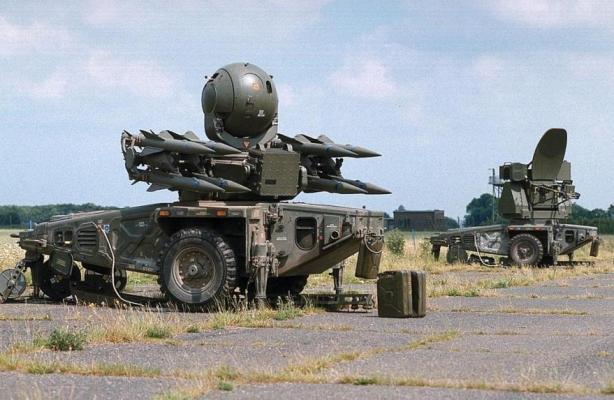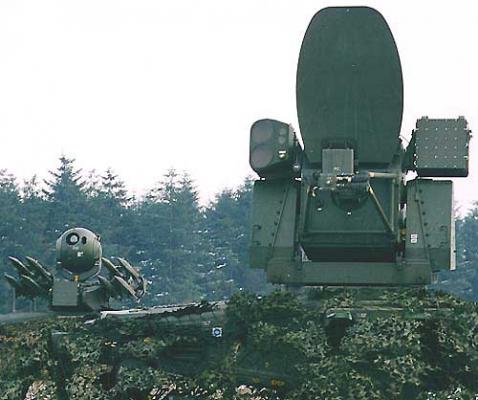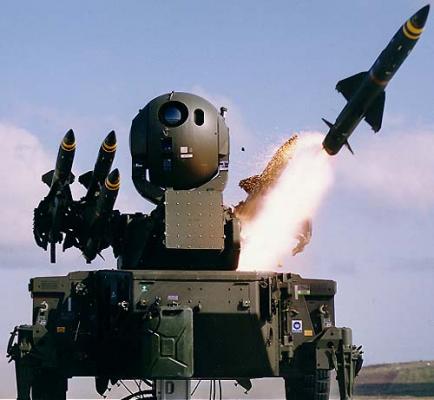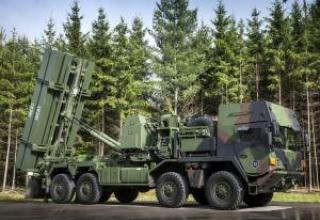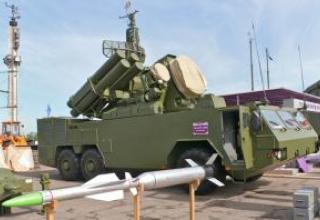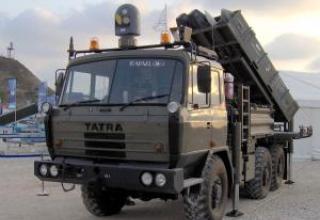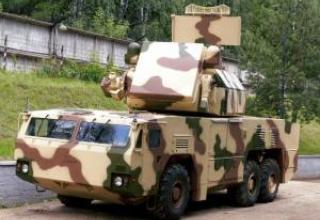The British aerospace company on the basis of the British Army's Rapier SAM system, which has been in service since 1971, has developed a new Rapier-2000 SAM system designed to fight low-explosive air targets, including cruise missiles, unmanned aerial vehicles, helicopter gunships in the conditions of active use by the enemy of REB.
It has better tactical and technical characteristics, such as higher interference immunity, firepower and the degree of automation of the combat process, as well as an increased number of guidance channels for the missiles. In addition, the new facility is reported to be resistant to nuclear explosion factors.
In 1995, the Rapier-2000 SAM system began to enter service with units of the British Army and Air Force. It was planned to produce 205 systems, in fact, as of 1997, 57 had been produced.
Composition:
All Rapier-2000" SAM equipment is placed on three unified single-axle trailers with autonomous power supply sources. One of them has a launcher with eight SAMs and an optical-electronic (heat and television) station for tracking targets and missiles, as well as a radio-frequency transmitter of SAM guidance commands, and the other has a radar for target detection "Dagger". and on the third, the Blindfire-2000 missile guidance radar. Towing of trailers is carried out by three 4-t vehicles of cross-country ability, in the bodies of which are transported on 15 ZUR. In addition, the complex includes two remote shooting controls (commander and operator), placed on tripods.
Each semi-trailer has its own diesel generator, air cooler and equipment for liquid cooling. The semitrailers are connected to each other by an optical-fiber cable that increases stability of work at influence of an electromagnetic pulse. All equipment is widely standardized, including power supplies, easy to test and replace.
Target detection radar "Dagger".
The Plessi Doppler Processing Coherent Pulse Dagger three-axis radar allows detecting and tracking up to 75 air targets on three coordinates simultaneously, as well as evaluating their threat level in a complex interference environment. When an anti-radar missile attack is detected, the station switches off automatically.
The radar antenna device, which is based on a flat lattice of 1,024 emitters, has a multi-beam (on the corner of the place) directional diagram with a low level of side lobes. A parallel diagram is used to form the antenna's directional pattern. The transmitter is made on a running wave lamp and equipped with a liquid cooling system. Parameters of the sounding frequency-modulated signal are determined automatically. Radar receiving device is created according to the superheterodyne scheme. When processing a signal, it uses double frequency conversion. Delay lines on surface acoustic waves are used as coordinated filters. Characteristic features of the "Dagger" station are quite significant radiation power at relatively small mass characteristics (mass 860 kg), a wide dynamic range of the receiver, high speed data processing and the use of super large integrated circuits, including up to 70 thousand logical elements. In addition, the radar has high reliability, as evidenced by the reliability of its operation (the average operating time per failure is 600 hours), as well as good performance (thanks to the built-in test, automatic control of all equipment, and the average recovery time is 30 minutes).
"Dagger" is equipped with a system of identification "its own - alien" by "Cososor Electronics", which, in addition to performing its main function, can be used to clarify the coordinates of the accompanied targets.
Blindfire-2000 guidance radar.
The "Blindfire-2000" monopulse radar station provides automatic tracking of air targets and pointing 3SD at them at any time of the day regardless of weather conditions. Being an upgraded version of the radar DN-181 of "Rapier" complex, it has higher stealth and noise immunity due to the use of a signal with linear frequency modulation. In addition, the new station on the side of the main antenna reflector (in place of the television camera) installed a continuous radiation transceiver device designed for rapid entry of the missile (before its capture radar "Blindfire-2000") on the line of sighting the target.
The method of pointing the SAM implemented in this SAM is similar to the one used earlier in the "Rapier" complex. It consists in the development of the "Blindfire-2000" signal proportional to the angular deviation of the missile from the target sighting line, which is then converted into control commands.
launcher
The launch unit of the Rapier-2000 SAM system is designed to accommodate eight missiles and is equipped with a hydraulic system. Its drive provides circular firing in the horizontal plane and rotation of the rails from the SAM on the angle of the place from -5 to +60° in the vertical plane. The PU is manually charged by two people. In order to increase the effectiveness of firing under the conditions of application of airborne radars, an opto-electronic station for tracking targets and missiles is placed on the PU. It consists of thermal imaging and television devices that provide automatic tracking of the target and the SAMs selected for firing. It uses Argus M700/40 microprocessors on large integrated circuits with the speed of 1.6 million operas per second.
Anti-aircraft guided missile
Rapier-2000" SAMs use single-stage "Rapier" Mk2 SAMs made according to normal aerodynamic scheme. In the middle part of the missile are stabilizer planes with receiving antennas of guidance commands, and in the tail - aerodynamic rudders and four tracers, providing the ability to track it in flight using optoelectronic station. The ZUR has a solid fuel dual-mode engine manufactured by Royal Ordnance. The missile can be equipped with two types of combat units: shrapnel and blast with a remote (laser) fuse to engage small targets, including cruise and anti-radar missiles) and semicombatted with a contact time fuse (to combat aircraft and helicopters of the enemy). The BC can also be detonated with a self-destruct vehicle if the arrival of commands on the missile is delayed by more than 0.5 seconds.
LSDs are characterized by increased reliability and, moreover, do not require adjustments and inspections for ten years. They are stored and transported in special containers.
The use of two independent command transmitters in the complex (at the Blindfire-2000 station and the launcher), as well as two tracking devices (optical-electronic radar) allows to fire two targets simultaneously.
Processing of information received from the radar "Dagger" or through a single network of air defense, missile launch and guidance are carried out automatically with the help of a special computer. However, if necessary, the operator can independently identify the most dangerous target and fire it in manual mode. In addition, the presence of a special sighting device allows the calculation of air defense systems to determine the angular coordinates (azimuth and angle of position) of the visually detected target (when other sources of information are absent) and transfer them to one of the means of escort.
The combat operation of the complex is as follows. Dagger" radar provides target detection, its state recognition and tracking. Information about the target's route is processed using an algorithm that assigns a target to be destroyed in accordance with predetermined priorities (for example, firing a target flying from a predetermined priority direction). The operator selects whether the target is tracked by radio or optronic. When a radar target is accompanied by the radar automatically, the operator presses the launch button when the missile and the target meet point in the kill zone. Then the launch vehicle is captured and pointed at the target. The commands for pointing the missile are transmitted to it via a command transmitter. Already when the missile is in flight, the complex can capture to escort the next target and to launch a second missile.
Modifications
Taking into account the traditional market of weapons specially for use in desert areas and countries with hot climate in the UK has developed an export version of the complex "Rapier-2000" - "Jernas". It includes a control cabin installed on the chassis of a light vehicle (4x4 wheel configuration), which houses the control panels of the commander and operator of the air defense system, as well as air conditioning.
Characteristics:
| Range of fire, km | |
| - minimum | 0,5 |
| - maximum | 8 |
| Target kill altitude, km | |
| - minimum | 0,15 |
| - maximum | 3,5 |
| Course parameter limit, km | 5,5 |
| Maximum target speed, m/s | 500 |
| Probability of hitting the target of one SSD | 0,6 |
| Guidance System | radio team |
| The reaction time, s | 5 |
| Deployment time, min. | 10 |
| TTH Rapier missiles Mk2 | |
| Starter weight, kg | 43 |
| Length, m | 2,24 |
| Maximum housing diameter, mm | 130 |
| Swing of stabilizers, mm | 380 |
| Maximum flight speed, m/s | 700 |
| Weight of BC (shrapnel- or semi-combustion), kg | 1,5 |
| TTH RLS "Dagger" | |
| Target detection range, km | 20 |
| Operating frequency range, GHz | 10-20 |
| Width of the azimuth pattern, deg | 2 |
| TTH RLS "Blindfire-2000" | |
| Target detection range, km | 12 |
| Operating frequency range, GHz | 30-40 |
| Emitted pulse power, kW | 40 |
| Pulse repetition rate, Hz. | 400 |
Testing:
As part of the UK's 12th Air Defence Regiment, Rapier SAMs participated in combat operations during the Falkland conflict in 1982. 12 launchers have been deployed since the first day of the English landing on the Falkland Islands. Sources from the English government (White Paper: The Falkland Campaign. Lessons) claim that 14 Argentine planes were destroyed by Rapier complexes. However, according to other information, the "Rapier" complex shot down only one AI Dogger A and participated in the destruction of the A-4C Skyhawk. The Blindfire radar did not participate in these hostilities.
The Rapier complex participated on the Iranian side in the war between Iran and Iraq in the 1970s, and is believed to have destroyed an Iraqi Tu-22 type bomber.
The "Rapier" SAM system was also deployed for the English multinational air defense contingent during Operation Desert Storm in 1991.
